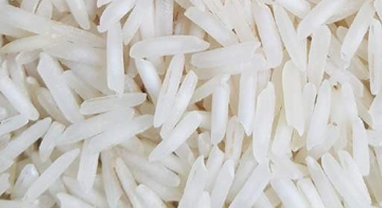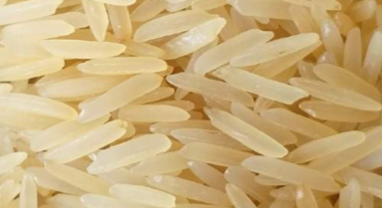Agro Products
Rice
1121 BASMATI RICE
It has the world’s longest grain, before as well as after cooking and gives 30% more volume than any other Basmati variety. 1121 Basmati Rice grade is known worldwide for its long length, excellent cooking qualities, unique aroma, special sweet taste and high nutritional value.



1718 BASMATI RICE
A new basmati variety,called Pusa 1718 is an improved versionof the iconic Pusa 1121. It is a modifiedrice seed of the Pusa 1121 basmativariety which is resistant to bacterial leaf blight and prevents flattening of crop duringrain, hailstorm or strong winds. The yield is also comparatively higher and ripeningof the seed also takelesser time thanother basmati varieties.



1509 BASMATI RICE
It has the longestgrain similar to 1121 but cheaper in comparison to 1121 rice variety because 1509 rice’s cultivation time is less and produces higher yield as compared to 1121 rice. Upon cooking, the grainsexhibit great elongation, excellent fluffiness, are non sticky and have a pleasant aroma.



PUSA BASMATI RICE
It is the 1st hybrid varietyof Basmati rice that boastsqualities like long grains, aromaticfragrance and non stickiness after cooking. Its distinctive taste,enticing aroma and high nutritional value have made PUSA BasmatiRice highly acclaimed in the international market.



1401 BASMATI RICE
It is an improved versionof PUSA hybrid Basmati Rice. After cooking,it comes out to be non-sticky, fluffy has the authentic flavor,aromatic fragrance and high nutritional value.



RAW RICE
After Paddy is harvested, its inedible husk is removed,Post husk removal,rice goes throughpolishing to remove the bran & then we get the white rice. White rice, also called as Raw rice are carefully produced while keeping all your concernsabout health and quality in mind.


Mango Pulp
Mango pulp is a thick, smooth concentrate made from ripe mangoes, typically of the Alphonso, Kesar, or Totapuri varieties. The mangoes are peeled, deseeded, and processed into a puree, which retains the fruit’s rich flavor, vibrant yellow color, and sweet aroma. It is commonly used as a base for juices, smoothies, desserts, and sauces, and is a key ingredient in many tropical dishes and beverages. Mango pulp is highly nutritious, being rich in vitamins A, C, and E, as well as antioxidants and dietary fiber, making it both delicious and healthy.



Pulses
Pulses are a group of leguminous crops that are harvested primarily for their dry seeds, including beans, lentils, chickpeas, and peas. They are a rich source of plant-based protein, fiber, vitamins, and minerals, making them a staple in many diets around the world. Pulses are an essential part of sustainable agriculture, as they fix nitrogen in the soil, improving soil health and reducing the need for chemical fertilizers. Consuming pulses regularly can have numerous health benefits, including supporting heart health, weight management, and digestive health. Additionally, pulses are versatile in cooking and can be used in a wide range of dishes such as soups, salads, curries, and stews



Millets
Millets are a group of small, cereal grains that have been cultivated for thousands of years, particularly in arid and semi-arid regions. They include varieties such as pearl millet, finger millet, sorghum, and foxtail millet. Millets are highly nutritious, rich in fiber, proteins, vitamins (like B vitamins), and essential minerals (such as iron, calcium, and magnesium). These grains are also gluten-free, making them an excellent option for those with gluten intolerance or celiac disease. Millets are known for their resilience to drought and harsh growing conditions, making them a sustainable crop for regions facing climate challenges. In addition to their health benefits, millets are versatile in cooking and can be used in porridge, bread, cakes, and even in savory dishes. They are also known to have a low glycemic index, making them beneficial for managing blood sugar levels



Groundnut
Groundnut, also known as peanut (Arachis hypogaea), is a leguminous plant that produces edible seeds commonly referred to as peanuts. It is widely cultivated for its high oil content and is a significant source of protein, healthy fats, vitamins (such as Vitamin E and B-complex), and minerals like magnesium, phosphorus, and potassium. Groundnuts are often consumed roasted, boiled, or in various processed forms like peanut butter, oil, and snacks. They are also used in cooking and baking due to their rich, nutty flavor. Groundnuts are known for their health benefits, including promoting heart health, supporting brain function, and providing energy. They are also versatile in agriculture, helping to improve soil fertility by fixing nitrogen, which benefits subsequent crops. Groundnuts are enjoyed globally and are an important crop in many countries, both for consumption and economic value



Jaggery and confectionery
Jaggery, a traditional unrefined sweetener made from sugarcane or date palm sap, is increasingly being used in confectionery as a healthier alternative to refined sugar. It is rich in minerals such as iron, calcium, and magnesium, and has a distinctive caramel-like flavor. In confectionery, jaggery can be used to make a variety of sweets, especially in South Asian cuisine. It is often used in traditional candies, desserts, and sweets like jaggery-based toffees, cakes, or ladoos, as well as in beverages like jaggery tea. Jaggery imparts a deep, rich flavor and offers a more complex sweetness compared to refined sugar.
Confectionery, on the other hand, refers to a wide range of sweet treats and candies made primarily from sugar, chocolate, or other sweet ingredients. The confectionery industry includes everything from chocolates and candies to pastries and gums. The use of jaggery in confectionery is gaining traction as people seek more natural, unrefined sweeteners. Confectioneries made with jaggery are perceived as a healthier option, offering the benefits of less processed ingredients while maintaining delicious flavors



Processed vegetables
Processed vegetables refer to vegetables that have been altered from their natural state for preservation, convenience, or enhanced flavor. The processing methods can include freezing, canning, drying, pickling, or even fermenting. These techniques help extend the shelf life of vegetables, making them available year-round, even when certain vegetables are out of season. For example, frozen vegetables are picked at peak ripeness and quickly frozen to retain their nutrients and flavor, while canned vegetables are preserved in jars or cans with added salt or preservatives. Pickled vegetables are preserved in brine or vinegar, often with added spices, and are popular for their tangy taste. Dried vegetables are dehydrated to remove moisture, allowing them to be stored for long periods without refrigeration. While processed vegetables offer convenience and long shelf life, they may contain added salt, sugar, or preservatives, so it’s important to choose options with minimal additives when possible.



Papad
Papad, also known as papadum, is a traditional Indian snack made from thin, crisp discs of dough, typically prepared from lentil flour, rice flour, or chickpea flour. It is seasoned with spices such as cumin, black pepper, chili, and garlic to add flavor. The dough is rolled into thin circles and then sun-dried before being fried or roasted to achieve a crunchy texture. Papads are often served as appetizers, side dishes, or accompaniments to meals, particularly with rice, curries, or chutneys. They are a popular snack in South Asia but have also gained popularity in other parts of the world due to their unique taste and texture. Papads come in various varieties, and their seasoning and flavors can vary regionally, making them a versatile and beloved food



